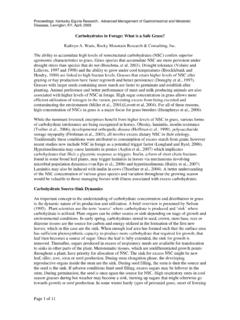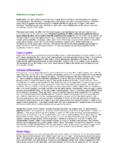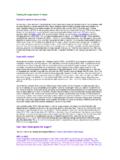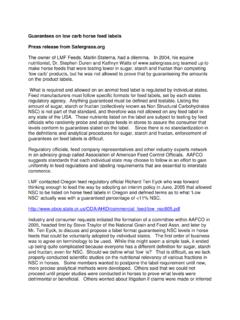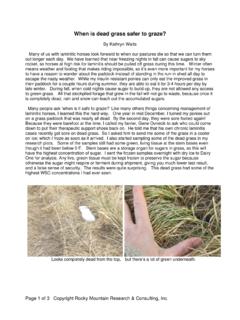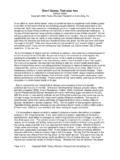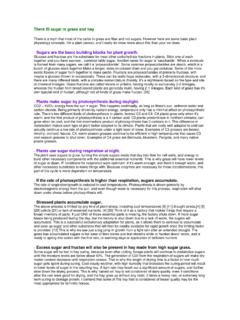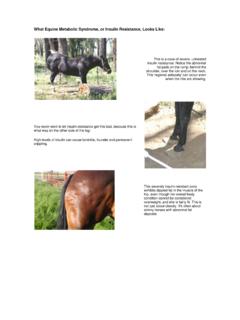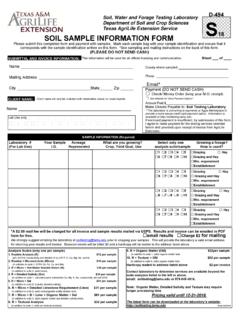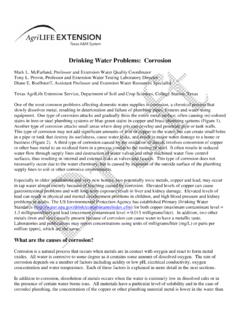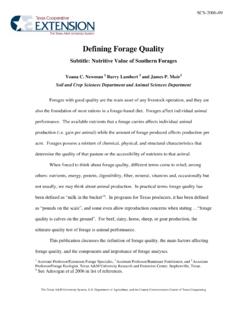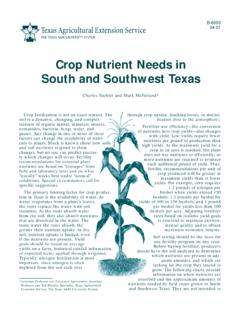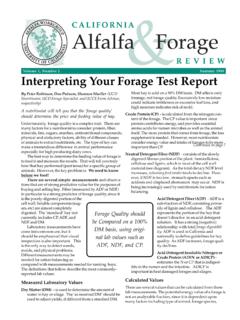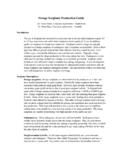Transcription of Unlikely sources of Excess Carbohydrate in Equine …
1 Journal of Equine Veterinary Science, Aug. 2005 25(8) p. 338-344 A Review of Unlikely sources of Excess Carbohydrate in Equine Diets Kathryn A. Watts, BS . Funded by Animal Health Foundation Take home message: Horses with Carbohydrate intolerance may encounter Excess nonstructural carbohydrates (NSC) in the form of grass hay, dying or dead grass, overgrazed pasture, and weeds, which may be higher in NSC than lush grass. Introduction Equines suffering from laminitis, insulin resistance, Equine Metabolic Syndrome, Cushing s, osteochondrosis, and Equine polysaccharide storage myopathy ( EPSM) require restriction of sugar, starch and/or fructan, which is collectively called Non Structural Carbohydrates (NSC). While there is a great deal of scientific literature in plant science journals regarding factors effecting NSC content of feed and forage, the information is not convenient to veterinarians.
2 The nomenclature that plant scientists use may be unfamiliar to veterinarians, as well as the concepts central to plant physiology. Attempts by some veterinarians to give advice regarding more appropriate feed choices and pasture management practices to owners of Carbohydrate intolerant equines may be based on incorrect assumptions, and incomplete understanding of the mechanisms governing NSC concentration in forage. This review is necessary to dispel some frequent misconceptions regarding NSC content of forage. Some forage that may be intuitively perceived as low in feed value, such as dead grass and weeds, may actually be high enough in NSC to trigger symptoms in susceptible animals. Grass founder has always been blamed on lush grass. The term lush is generally considered to mean green, vigorous, and well hydrated.
3 Advice given by veterinarians on methods to avoid lush grass may actually increase NSC concentration1. This review will demonstrate how brown, dead or dying, desiccated grass can have surprisingly high levels of NSC, and explain the concepts of plant physiology that govern NSC accumulation in grass. This may explain onset of some previously mysterious cases of endocrinopathic laminitis, or worsening of symptoms in other diseases involving Carbohydrate intolerance. There are some common misconceptions about the relative levels of Non Structural Carbohydrate (NSC) in horse feeds. While most horse owners recognize that molasses and grain are high in sugar and starch, they do not realize that Excess NSC may be found in other portions of horse rations.
4 This review of the NSC content of the non-grain portion of Equine rations may provide practitioners and caretakers with information to fine-tune the diets of CHO intolerant equines. Misconceptions about NSC content of common feeds The following Table 1 contains data from the online database of Dairy One Forage Analysis Laboratory, of Ithaca, NY over several years. NSC as tested by this lab includes sugar, fructan and starch. Other laboratory tests may not be equivalent, as procedures are not standardized. Evidence reported by owners of horses suffering from refractory endocrinopathic laminitis suggests that replacing high NSC hay with hay containing less than 10% NSC on a dry matter basis may alleviate symptoms. Journal of Equine Veterinary Science, Aug. 2005 25(8) p. 338-344 Table 1.
5 NSC content of some common feeds Mean NSC Normal range Grass hay Alfalfa hay Oat hay - Straw Bermuda hay Beet pulp Soybean hulls Wheat bran Oats Corn Barley Molasses % dry matter basis, from Dairy One feed composition library, Ithaca, NY Note that the normal range for grass hay includes a two-fold difference in NSC content. Some grass and hay, and even straw may be too high in sugars for CHO intolerant animals. Many people consider oat hay less rich , than the alternative, which is often alfalfa. While alfalfa has more protein than oat hay, it averages half the NSC as oat hay, although it can go as high as 20% NSC under certain conditions. Protein is no longer being implicated as a cause of laminitis in horses.
6 Average oat hay is too high in NSC for most Carbohydrate intolerant horses. Note the high normal range of oat hay goes up to 29% of dm. This author has tested pre-heading oat hay repeatedly frozen in late fall that was 35% NSC dm. This is mostly sugar and fructan, not starch, and is not the consequence of fully formed grain. Sugar and fructan are precursors for starch formation, and are found in high levels in the stem before seed heads fully develop, which is when most oat hay is cut. Grass and hay from cool season grasses like orchard, brome, timothy, fescue, and Kentucky bluegrass will tend to be higher in NSC when grown in climates with intense sunlight and/or cooler nights. Bermuda grass hay is generally considered to be lower in NSC, when compared to cool season grasses, but note the wide range in NSC concentration.
7 Bermuda grass hay is often low in NSC in the southern parts of the US, where high humidity creates cloudy conditions, minimizing photosynthesis and production of sugars, while slow hay drying maximizes respiratory loss of sugars. The same variety of Bermuda may be too high for CHO intolerant horses when grown under sunny, arid conditions, such as found in California. The NSC figures on the higher end of the normal scale will represent these conditions. Some horses do not thrive on straight alfalfa diets, possibly due to Excess protein that may then be metabolized as energy. Some horses exhibit sensitivity to even small amounts of alfalfa due to some as yet undefined component other than NSC. Many Carbohydrate intolerant horses do well on small amounts of alfalfa necessary to bring protein levels up to optimum when mixed with other low protein grass hay or straw.
8 It seems logical to many horse owners that brown, stemmy, over mature hay should be low in sugars. While there is a general tendency for over mature hay to be lower in NSC, stressful environmental conditions just before hay cutting are more important than stage of growth. (Chatterton, Watts, unpublished data) Many cases of refractory laminitis have been resolved Journal of Equine Veterinary Science, Aug. 2005 25(8) p. 338-344 after testing disclosed that the coarse, unattractive hay being fed contained unacceptably high levels of NSC. It is imperative that testing for NSC by an appropriate forage testing laboratory be conducted before purchasing hay for CHO intolerant horses. Bran is considered by many people to be mostly fiber, and is often fed on an occasional basis, such as a special treat on a cold morning, or to an ailing horse.
9 Note that wheat bran averages 31% NSC, which is nearly triple the amount of NSC than average grass hay. Bran also has a very wide range of NSC, depending on how much of the flour has been left in the bran. Some feed stores may substitute wheat middlings or even mill run wheat for wheat bran, and will adamantly contend that it is the same thing as bran. Advise clients of CHO intolerant horses to avoid wheat bran. Dead grass can be high in NSC When cool season grasses are subjected to freezing temperatures, growth slows or ceases, but they do not go dormant immediately. If daytime temperatures are above freezing, and are sunny, sugars continue to form and can accumulate. In autumn, those parts of a grass plant that are still green may have the highest sugar and/or fructan concentration of the year.
10 High levels of sugars act as a cryoprotectant in grass, up to a point2. Even very high levels of sugars cannot protect against cellular death when temperatures get well below freezing. When plant cells die and rupture from freezing, these accumulated water-soluble sugars and fructans may then be leached out by late fall rains, or early winter snows that melt during the day. However, in areas with little or no rainfall, these accumulated sugars remain in the dead tissue. Under extreme low humidity, snow may sublime rather than melt. Some grasses have a protective, waxy cuticle layer, which resists leaching of nutrients even when completely dead and brown. Such is the case with fescue, which is known for its ability to maintain nutrients when fed as standing hay or stockpiled forage.
